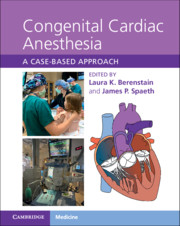Book contents
- Congenital Cardiac Anesthesia
- Congenital Cardiac Anesthesia
- Copyright page
- Dedication
- Contents
- Contributors
- Introduction
- Chapter 1 A Congenital Heart Disease Primer
- Section 1 Left-to-Right Shunts
- Section 2 Right-Sided Obstructive Lesions
- Section 3 Left-Sided Obstructive Lesions
- Section 4 Complex Mixing Lesions
- Section 5 Single-Ventricle Physiology
- Section 6 Heart Failure, Mechanical Circulatory Support, and Transplantation
- Section 7 Miscellaneous Lesions and Syndromes
- Chapter 40 Idiopathic Pulmonary Hypertension
- Chapter 41 Pulmonary Hypertension and Congenital Heart Disease
- Chapter 42 Pulmonary Hypertension and Prematurity
- Chapter 43 Pulmonary Hypertension and Moyamoya Disease
- Chapter 44 Vascular Ring
- Chapter 45 Pericardial Effusion
- Chapter 46 Kawasaki Disease
- Chapter 47 VACTERL Syndrome
- Chapter 48 Hurler Syndrome
- Chapter 49 Long QT Syndrome
- Chapter 50 Marfan Syndrome
- Index
- References
Chapter 42 - Pulmonary Hypertension and Prematurity
from Section 7 - Miscellaneous Lesions and Syndromes
Published online by Cambridge University Press: 09 September 2021
- Congenital Cardiac Anesthesia
- Congenital Cardiac Anesthesia
- Copyright page
- Dedication
- Contents
- Contributors
- Introduction
- Chapter 1 A Congenital Heart Disease Primer
- Section 1 Left-to-Right Shunts
- Section 2 Right-Sided Obstructive Lesions
- Section 3 Left-Sided Obstructive Lesions
- Section 4 Complex Mixing Lesions
- Section 5 Single-Ventricle Physiology
- Section 6 Heart Failure, Mechanical Circulatory Support, and Transplantation
- Section 7 Miscellaneous Lesions and Syndromes
- Chapter 40 Idiopathic Pulmonary Hypertension
- Chapter 41 Pulmonary Hypertension and Congenital Heart Disease
- Chapter 42 Pulmonary Hypertension and Prematurity
- Chapter 43 Pulmonary Hypertension and Moyamoya Disease
- Chapter 44 Vascular Ring
- Chapter 45 Pericardial Effusion
- Chapter 46 Kawasaki Disease
- Chapter 47 VACTERL Syndrome
- Chapter 48 Hurler Syndrome
- Chapter 49 Long QT Syndrome
- Chapter 50 Marfan Syndrome
- Index
- References
Summary
Pulmonary hypertension in preterm infants is defined by the same guidelines used for adults and children: mean pulmonary arterial pressure =20 mm Hg, pulmonary capillary wedge pressure <15 mm Hg, and indexed pulmonary vascular resistance >3 Wood units/m2. Bronchopulmonary dysplasia, the major cause of chronic lung disease in preterm infants, is defined as the need for oxygen at 36 weeks postconceptual age in infants born at or before 32 weeks’ gestation. The disruption of growth and function of the pulmonary vasculature observed with bronchopulmonary dysplasia contributes to the development of pulmonary hypertension. Abnormal pulmonary vasculature develops increased pulmonary vascular resistance and mean pulmonary artery pressures. As many of 20%–40% of patients with bronchopulmonary dysplasia have persistent pulmonary hypertension and the combination is accompanied by significant morbidity and mortality. This chapter details the assessment and perioperative considerations involved in caring for a preterm infant with these conditions undergoing multiple surgical procedures.
Keywords
- Type
- Chapter
- Information
- Congenital Cardiac AnesthesiaA Case-based Approach, pp. 323 - 330Publisher: Cambridge University PressPrint publication year: 2021



